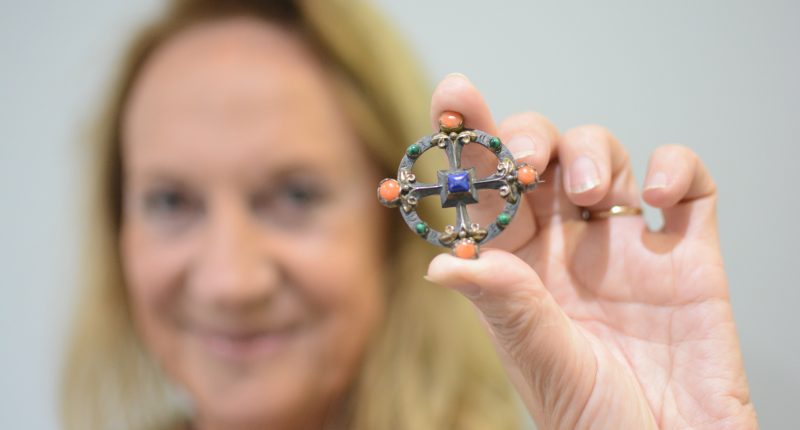A WOMAN who bought a brooch for £20 at a market stall has now made her £11,000 richer thanks to a special detail.
Flora, who is a Rome-based jewellery enthusiast, bought the brooch in 1988 at a Midlands antiques market.
The silver, coral, lapis lazuli and malachite brooch was left with her personal collection for years.
But little did she know the brooch was actually worth a staggering price until a chance encounter unveiled its real value.
She was watching an episode of The Antiques Roadshow when she spotted a similar design.
Her £20 innocent purchase turned out to be a valuable treasure worth thousands.
READ MORE SUN STORIES
The BBC show featured the silver item during a 2023 Christmas special.
Flora said: “The whole process of making the discovery, appearing on one of my favourite TV programmes and now seeing the brooch sell has been such an unexpected and joyful experience, especially coming as it has after a difficult time.
“And of course, this has confirmed selling it is most definitely the right decision as I don’t think I would dare wear it now that I know what it’s worth.”
Experts confirmed it was a long-lost original from Victorian Gothic Revival architect William Burges.
Most read in Money
The piece of jewellery was given as a wedding gift to a relative of the a British military leader.
It was crafted for the great-niece of Admiral Lord Horatio Nelson Caroline Bendyshe 160 years ago.
Gildings director Will Gilding said: “160 years on from the wedding it was made for, it’s wonderful to see this incredibly special piece of jewellery emerge from obscurity as it moves on to its next chapter with a new owner who will treasure it for years to come.
“Also, it just goes to show, you never know what hidden gems could be hiding in your jewellery box.”
The valuable artefact fetched a whopping £11,780 at Gildings Auctioneers, in Market Harborough.
Flora, who fought breast cancer for two years, is now planning to give away the cash to her family and a cancer charity.
But this is not the only time a William Burges brooch is being spotted.
A pensioner previously discovered a similar piece – which then sold for £31,000 in 2011.
Later the same year, another viewer realised they had the same one.
Mr Gilding added: “We’re absolutely delighted to have achieved this great result for Flora’s very special piece of jewellery.
“After a local lady brought her brooch to us instead of the local market in 2011 after seeing the sketches on Antiques Roadshow, we were astonished when another owner got in touch after seeing footage of that first find.
“So, for this to happen again thirteen years on with Flora bringing us a third example of a lost Burges brooch almost beggars belief.”
READ MORE SUN STORIES
It comes as a couple bought a dusty old chair for £5 at an auction have found a £5,000 treasure trove stuffed down inside of seats.
Angela Milner-Brown and husband Angus from South Lanarkshire, Scotland, were struck by luck after spotting diamonds inside the ordinary chair.
What to do if you find treasure?

UNDER the UK’s 1996 Treasure Act, finders of potential treasure are obligated to report their discoveries to the local coroner within a timeframe of 14 days.
The British Museum’s Portable Antiquities Scheme works to advise treasure finders of their legal obligations alongside writing reports for coroners on each individual discovery and running the administration for the Treasure disclamation process.
The Treasure Act facilitates the purchasing of finds by both national and local museums for the public benefit — with a reward from such typically given and split between the finder and the landowner.
The size of the rewards are equal to the full market value of the finds, as determined by the Secretary of State, following guidance from an independent panel of experts called the ‘Treasure Valuation Committee’.
The act also helps to guide what is and isn’t considered as treasure — with the final determination for individual items made at an inquest.
At present, the following, for example, are defined as treasures:
- Finds of two of more 300-years-or-older coins from the same location, unless they contain less than 10 per cent gold or silver, in which case there must be at least 10 in the find to qualify as a treasure.
- Two or more prehistoric base metal objects found in association.
- Any non-coin artefact that is at least 300 years old and contains at least 10 per cent gold or silver.
- Any object found in the same place as another treasure.
- Deliberately hidden objects whose owners or heirs are unknown that are less than 300 years old but are made predominantly of gold or silver.
However, following a public consultation, a new definition is to be developed in the future — one which will account for the cultural and historical significance of a find, rather than just its material qualities.











